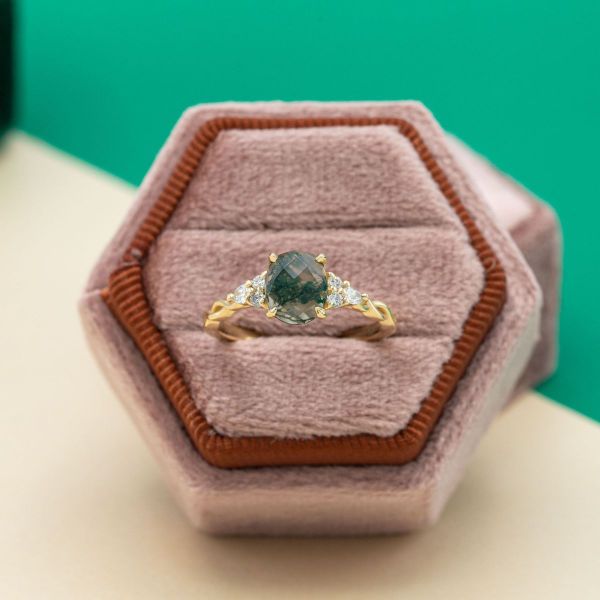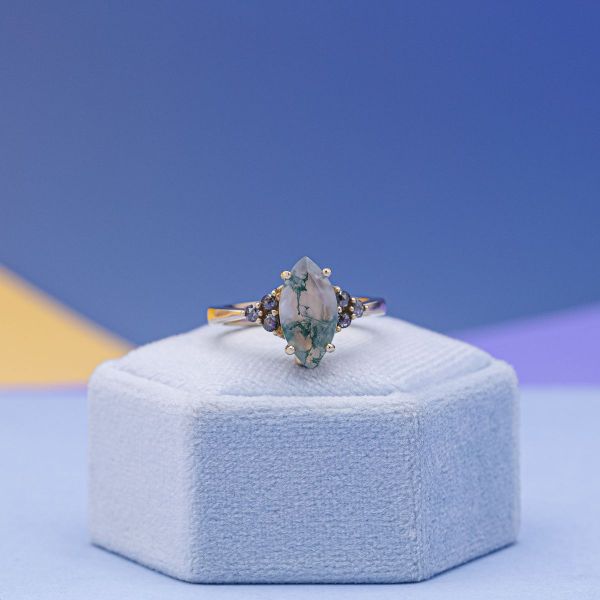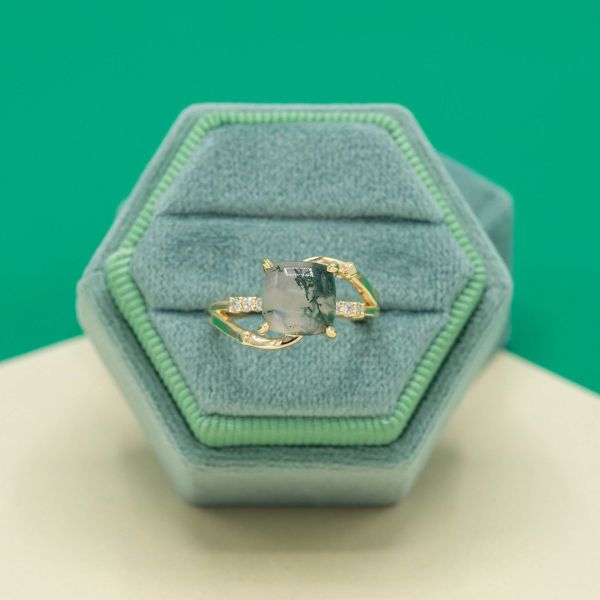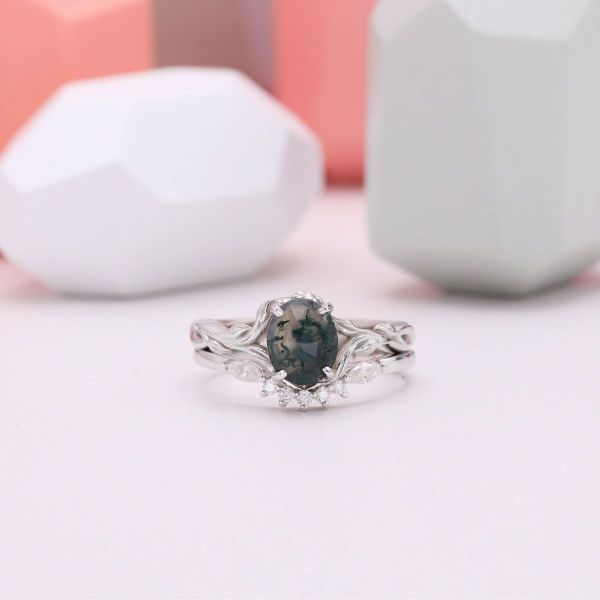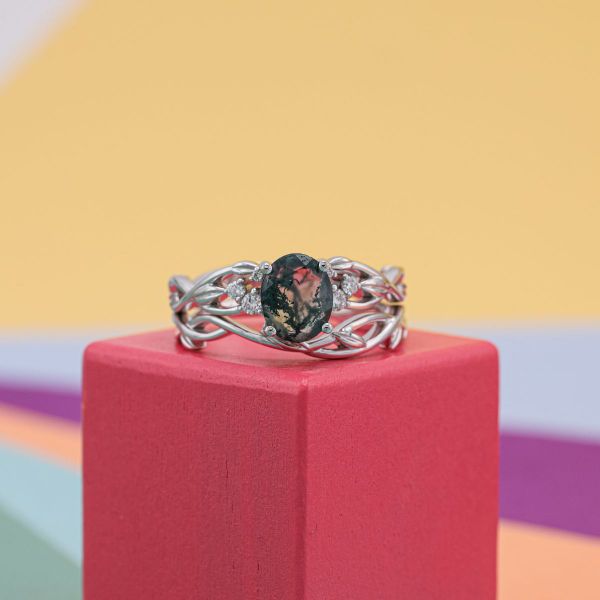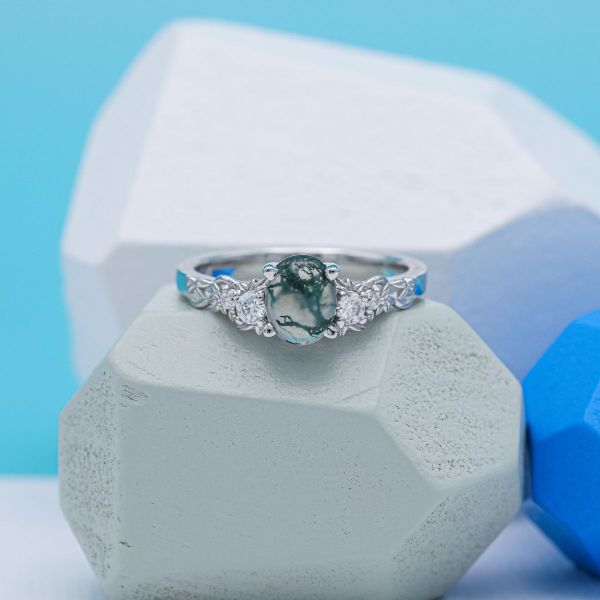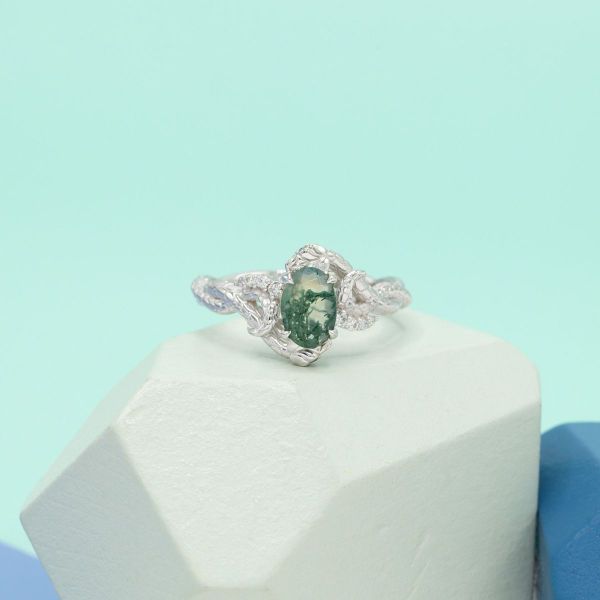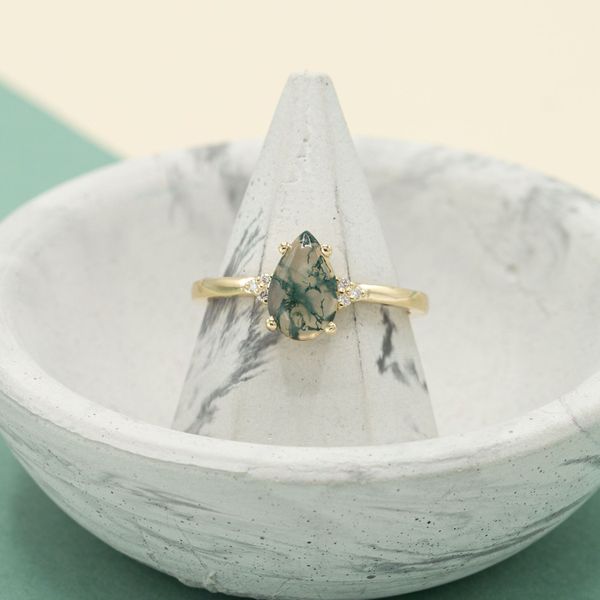Gemstone Knowledge
The visual appeal of moss agate
Understanding moss agate and the various styles among individual stones
The nature-inspired look of moss agate
Moss agate has a natural beauty that’s tough to ignore! This stone’s organic appeal is the result of soft white and green hues coming together to create a marbled, mossy look that many couples are beginning to choose for their unique engagement rings. It’s hard to believe with a small color palette and a handful of inclusions, but moss agate can actually produce a wide variety of looks where no two stones are exactly the same. Let’s take a closer look at moss agate, particularly what it is, where it gets its soothing, nature-themed colors, and a few ways these hues and inclusions combine to create one-of-a-kind gemstones for engagement rings.
What is moss agate?
So what exactly is moss agate? For starters, moss agate is a type of chalcedony formed from silicon dioxide. Also known as silica, silicon dioxide is the main ingredient in quartz, making moss agate a member of the quartz family alongside amethyst and citrine. Because it’s a type of chalcedony, moss agate is also related to other alternative engagement stones such as onyx and carnelian. Chalcedony is a term used to describe gemstones that are made up of smaller component crystals that are too tiny to see with the naked eye. In fact, the name “chalcedony” comes from the Greek word for “hidden”, which is a pretty apt name for the minute crystals that make up gemstones like moss agate. So moss agate isn’t actually just one stone, but rather it’s made up of multiple tiny stones that are so small they feel smooth to the touch and appear as one–neat! This is all well and good, but what makes moss agate so, well, mossy?
What gives moss agate its unique color?
Moss agate gets its name from the green, mossy inclusions that run throughout each stone. These inclusions take several forms, from oxides of manganese and iron to a mineral known as chlorite, which all provide some form of green hue. Regardless of origin, the green inclusions in moss agate run in various directions through the stone, producing several different patterns and giving it that signature mossy appeal. These green inclusions are readily visible because moss agate typically comes in two main colors: translucent or white. These base colors are incredibly light, highlighting any inclusions and allowing them to take center stage. Inclusions and base colors come together to form a variety of different looks, and each stone has its own personality.
In the gemological world, there really aren’t any rules when it comes to color quality for moss agate: a good moss agate is the one you love most! Now that we’ve gone over the basics, let’s discuss the many ways moss agate’s base colors and inclusions come together to produce different styles of this unique gemstone.
Styles of moss agate
Base color
Like we mentioned previously, moss agates have translucent or white backgrounds. While they may seem similar, these colors individually impact how inclusions appear within your moss agate! What’s more, each color offers its own take on the natural mystique of moss agate, so it’s important to look at stones with both colors to understand which one is more your style.
Let’s start with translucent backgrounds. A translucent base color is mostly clear, giving you an uninhibited view through the stone and an up close and personal look at all of its intricate inclusions. Translucent backgrounds give wearers an opportunity to appreciate the depth of moss agate’s inclusions, allowing you to see them at different levels within the stone. Translucent moss agates also help inclusions show their true colors, giving them a clear backdrop for their vibrant green hue. You can find translucent moss agates that are so heavily included you can barely see through the stone, or there are others that only feature minor lines and splotches of color for a clearer stone overall. Translucent backgrounds can even have a little sparkle if you choose the right cut, as brilliant cuts have more facets for light to bounce through their clear bodies and highlight corners and edges.
Then, there are moss agates with white backgrounds, providing a more opaque take on that nature-themed design. When we say white, we don’t just mean copy paper white. In fact, white for moss agate can mean a frosty white that blurs the edges of inclusions, a milky white that swirls into patches of color, or even a grayish white that resembles a foggy morning in a quiet forest glen. Again, white backgrounds tend to be opaque, which means you can’t see through them as easily when compared to the clear view of a translucent stone. However, white moss agates have their own personality, making any inclusions near the surface of the stone more vibrant due to their contrast against the white background. Inclusions can also rapidly disappear under the surface of that white color, just like twigs and leaves vanishing under newly fallen snow. The white color of these moss agates combines well with that signature green hue, creating new colors in the process as inclusions and the stone’s base color swirl together to produce something entirely new. White moss agates look amazing in any cut, but a cabochon or style with fewer facets gives you ample space to admire each stone’s inclusions.
In addition to the two main base colors for moss agate, there are also several types of inclusions that make up this stone’s mossy appeal. Let’s examine several styles of inclusions for a better understanding of how they interact with each base color.
Inclusion patterns
When it comes to moss agate, its inclusions come in many shapes and sizes. One of the most common inclusions is filaments or threadlike green lines that almost resemble dark blades of grass running through the stone. Moss agate may also contain dendritic inclusions, which create branchlike patterns that spread across the stone like the mossy branches of an old tree. Finally, there may be formless swirls or splotches of color that gently mingle with the background hue of moss agates for a melting effect that blends the colors within the stone. These inclusions often look like drops of food coloring in water or milk, slowly spreading and whirling into the liquid.
Moss agates may contain just one or multiple types of these inclusion patterns, and some barely have any at all for couples seeking a simpler, cleaner stone with a touch of natural beauty. However, many couples fall in love with the heavily included look of moss agate, preferring a variety of inclusions that span the entire stone for a one-of-a-kind engagement ring.
Inclusions can also vary in color, although most of them will have that verdant green hue we associate with moss agate. While their true color essentially remains the same, inclusions can take on the appearance of lighter or darker shades of green depending on each moss agate’s background color and where they sit within the stone.
For instance, filaments that run from the surface to the very bottom of the stone may appear different colors at varying depths. This is similar to when you dip a leaf halfway into a pond: the color varies between the dry part of the leaf and the parts that are at different depths within the water! What’s more, patches of color may fade or swirl into the background color near the stone’s edges, creating a lighter version of that gorgeous green hue.
But not all inclusions are green either! Remember when we mentioned the chlorite that often creates moss agate’s green color? Chlorite contains iron, which can oxidize and produce brown or red inclusions instead. You can even find moss agates that exhibit all three colors for a warmer take on that rustic look.
As you can see, there are many ways to mix and match the neutral base colors and lively green inclusions of moss agate to produce a unique stone. And much like the beloved couples we work with, no two moss agates will ever be exactly alike. We recommended taking your time and looking at many stones while creating your engagement ring to find the right one for your aesthetic.
Finding the right moss agate for your needs
Since there’s no right or wrong when it comes to moss agate’s color quality, you can peruse stones to your heart’s content to find the right one for you and your partner. By looking at stones with both translucent and white base colors, you can get a better idea of how inclusions manifest themselves and figure out which style of moss agate best suits your dream engagement ring. And if you can’t decide right away, don’t sweat it! There’s no need to rush such a personal, lifelong decision, so consider consulting our team to help you design a moss agate engagement ring you’ll want to wear for decades to come.
About CustomMade
CustomMade designs and creates one-of-a-kind, custom engagement rings and fine jewelry. Each piece we create is inspired by you, designed for you, and made just for you.

